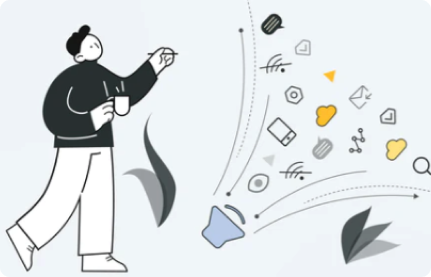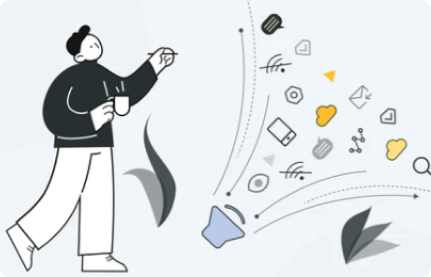This article takes imToken decentralized wallet as an example. The situation may vary slightly for other digital asset wallets, so please consult the official customer service of the relevant wallet for specific information.
Misunderstandings are common among people, often due to a need for more understanding. Similarly, when we encounter new things, such as decentralized wallets, these misconceptions can take root in our minds wildly because blockchain technology differs significantly from the centralized services we are used to.
Below are five common misunderstandings newcomers may have when they are using decentralized wallets for the first time. Have you fallen for any of them?
1. All my assets are "stored" in the imToken wallet.
A wallet's essential function is managing assets, which allows people to transfer or receive payments. It is similar to the account function of a centralized exchange platform. However, unlike centralized platforms, your digital assets don't store with the decentralized wallet service provider, and there is no asset custody relationship between you and the provider.
Decentralized wallets do not have your wallet's mnemonic phrase, which differs from centralized platforms, that control and manage your assets. Users cannot access mnemonic phrases or other information related to centralized platform addresses.

( Image source: Dalby, Wendland & Co. News )
In contrast, decentralized wallets are only to manage your assets. You are able to control the mnemonic phrase and private key and authorize transfers or transactions using your private key.
Remember: whoever holds the mnemonic phrase holds the assets.
2. I can ask customer service for a refund for sending assets to a wrong address.
Blockchain wallet addresses are generally long strings of characters, more complicated and harder to remember than bank account numbers.
People generally obtain the recipient's address by copying it or scanning a QR code. Filling in the wrong address is rare, but sometime mistakes ocucrrs, such as mis-copying the token contract address as the receiving address, resulting in incorrect assets transfers. In most cases, it is impossible to reverse such transactions.
Once a blockchain transaction has been confirmed, it cannot be frozen or reversed. The only option is to contact the recipient and ask them to return the assets. However, due to the anonymity of the recipient, it is difficult to confirm the true identity of the wallet address owner. Therefore, if you transfer assets to the wrong address, you are almost certain to have lost those assets.
Therefore, it is essential to double-check the address before transferring. In addition, you can use some convenient features of the wallet to ensure the correctness of the address, such as the "My profile > Address Book" feature of the imToken wallet, where you can save commonly used addresses for easy access during transfers.

Of course, you can also use ENS domain name services to create a simple and memorable wallet address.
3. The amount of my assets is incorrect; please adjust it for me.
We need to start from the source to answer this question. How do we access the information of your wallet?
All of your digital assets are just lines of cold data on the blockchain, and their original appearance is not very user-friendly, such as:

To make it easier for users to read their asset information, programmers have improved the data's visual appearance and added interactive design elements to make it more user-friendly.

We already know that the asset status corresponding to each address in the wallet is directly grabbed from the chain, which is consistent with the query results of the block browser. Therefore, the wallet is only a display in front of the user in a more friendly way.
When you notcie the asset information is wrong, you can query and cross-verify your asset status through the block browser.
4. The DApps that can access by the DApp browser are all related to imToken.
We must first understand what a "DApp browser" is to resolve this misunderstanding.

Let's leave aside the first four letters "DApp" for now. When it comes to browsers, you should be familiar with commonly used browsers such as Chrome, Safari, Firefox, and IE, which we often visit sebsites through. Therefore, the meaning of "DApp browser" is quite obvious: a tool for accessing DApps, which are natural products of blockchain technology. In this way, the DApp browser was born, and in most cases, it embeds in the wallet application as a native function.
In addition to directly accessing the third-party DApp connected to the wallet, you can also enter the URL of the relevant DApp through the DApp browser to access it. But being able to access it doesn't imply that this DApp is related to the wallet service provider. It is similar to that you can visit CNN with Safari browser--it does not mean that these two are related.
Here is a reminder: Many fraudulent DApp projects will use this information gap to cheat and create an illusion for users that the project is related to the wallet.
5. imToken can only manage ETH assets.
Most users' impression of imToken is still imToken 1.0, thinking that imToken can only manage tokens on ETH and its main network. Users often ask: When will imToken support BTC? TRX? Or other assets?
We'd like to announce: imToken currently supports a total of 12 chains of ETH, BTC, EOS, COSMOS, BCH, LTC, CKB, TRX, KSM, DOT, FIL, and XTZ. Users can manage their assets on these 12 mainnets with just a set of mnemonics.
This article refers to the imToken Help Center. imKey hardware wallet is suitable for this content.



